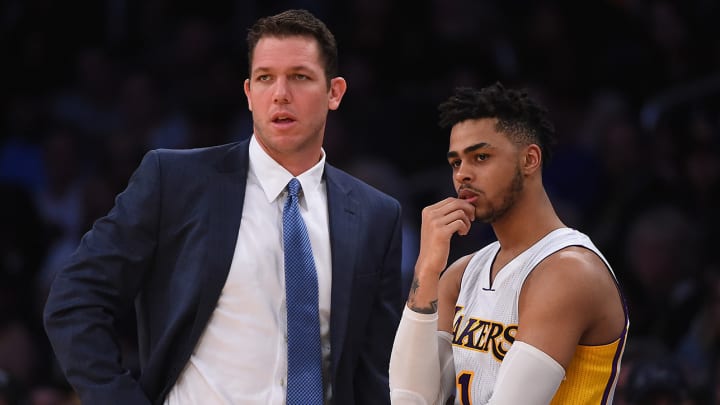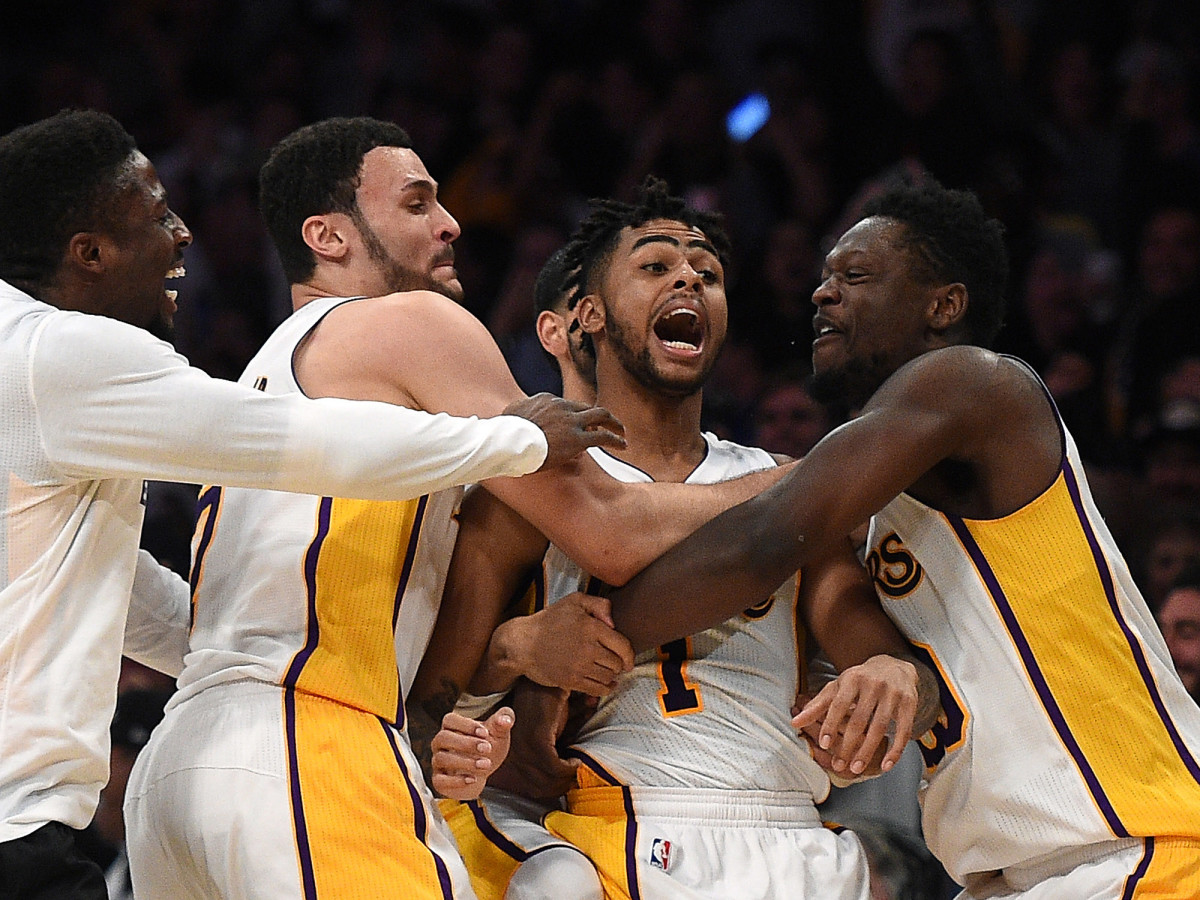NBA Off-Season Preview: Lakers Will Have Massive Opportunity On Draft Night

While the NBA playoffs are still going, the 2017 off–season is rapidly approaching for many teams with massive decisions to make.CBA expert Danny Lerouxbreaks down the major challenges and opportunities for theLos Angeles Lakers in The Crossover's NBA Summer Preview series.
On Tuesday night, the Lakers got something very close to their best-case scenario. Beyond keeping their top-three protected first round pick, they also have a very good chance to have local product Lonzo Ball on the board when they pick second overall. That good fortune also means that the team will not have to send a 2019 first round pick to Orlando, instead shipping their second round choices in 2017 and 2018 in order to complete their 2012 trade for Dwight Howard. Beyond providing an opportunity to add an elite young player to the mix, picking second should force the overhauled front office to evaluate their entire roster with fresh eyes. That will be necessary since proactive moves will both hasten their return to the playoffs and raise their ceiling down the line. After all, success is the by-product of that preparation. However, proactivity and impatience are two very different things and the franchise will keep that reminder on their cap sheets in the form of Timofey Mozgov and Luol Deng’s onerous four-year contracts.
Here are three key storylines to watch for the Lakers this offseason:

No. 2 pick: After putting themselves on the precipice of losing this selection, the Lakers will have a massive opportunity on draft night. While Markelle Fultz and Ball are the two favorites for the choice as of now, the front office needs to consider all of their available options. That resonates even more strongly since the Lakers will not have their first round pick next year, meaning this is their only good shot at an elite draft talent in the next two summers at minimum. Even though they have intriguing talent at a few key positions, no one has established themselves so indelibly to shift the choice away from best player available.
Cap space: The Lakers are in a fascinating place that is eerily similar to last summer because they have money to spend but would be wise to be judicious. Other than Corey Brewer and potentially Tarik Black, they have very little in the way of expiring salary in 2018, so whatever money they commit to now directly weakens their position next summer. Unless a young talent like Gordon Hayward expresses interest, they would likely be better served retaining that flexibility for next summer when the team has more buzz and some logical free agent fits.
The Lottery: Behind The Scenes Of The NBA's Weirdest Tradition
Julius Randle extension: The first of the Lakers’ lottery picks to become extension eligible may be the hardest to get done, considering their roster is in flux and Randle has not proven his place in the rotation. As such, the front office would be wise to make a strong demand and hold to it because having the forward hit restricted free agency is far from devastating, especially since his $12.4 million cap hold would be manageable.
Potential Free Agents: Nick Young ($5.7m Player Option), Tarik Black (Non-Guaranteed), Tyler Ennis (Unrestricted), David Nwaba (Team Option), Thomas Robinson (Unrestricted) and Metta World Peace (Unrestricted)
Likely Summer of 2017 Cap Space: $17 million
Realistic Maximum Summer of 2017 Cap Space (using $101M estimate): $22.8 million
2017 Draft Assets: Own first round pick (2nd overall) and Houston’s first round pick (28thoverall) from the Lou Williams/Corey Brewer trade. Second round selection will go to Orlando.
2017 NBA Mock Draft: Fultz To Celtics At No. 1?
Potential Targets: As discussed above, spending wisely should be the team’s biggest priority instead of focusing on specific players. In an off-season with fewer franchises possession game-changing salary cap space, the Lakers should keep the door open for value contracts like Seth Curry signed with Dallas last summer and those should be available but are hard to predict ahead of time. While their own young players will take precedence, they could also try to solicit offers for some of their 2017-18 salary cap space if another team needs to clear some room quickly but the problem is that it would have to be expiring contracts only unless that trade partner proved willing to attach a serious asset. Even so, just being on those calls opens the door for something beneficial. The Lakers could also be a destination for one-year “make good” contracts for veterans frustrated with their offers, because Los Angeles provides a ton of visibility but having so many players to evaluate makes that pitch tougher than in recent years.
Pressure Scale: 7. Unlike most franchises, the Lakers’ biggest pressure this off-season comes in June and October rather than July. It is still a long road back to relevance but the second overall pick can be a major part of that growth if they make the right choice. The Lakers also have fascinating decisions with the No. 28 pick and extending Randle that will matter as well. The draft pick is more of an upside play, with success meaning a potential contributor on team-friendly terms for four seasons. Randle’s next contract could go either way, with an overly lucrative deal becoming a factor on their books for years to come while a reasonable one could help them in the future either by keeping him around or by creating a trade piece. Amazingly, their still-significant cap space is almost ancillary but like Randle’s extension could meaningfully affect their opportunities in 2018 and beyond.
State of the Franchise: Setting the table. The Lakers’ off-season is fascinating because it marks their best opportunity in years to lay the groundwork for a competitive team. The second overall pick is never guaranteed to become a star, but they will get four years on a rookie scale contract and then match rights through restricted free agency. That pick will also help clarify the vision for the team, particularly if the front office feels their draftee directly conflicts with D’Angelo Russell.
While the Lakers could approach a potential overlap by giving both players the opportunity to shine, that often proves hard to maintain for a head coach and Russell will be extension-eligible next summer. This could also occur on a smaller scale with Jordan Clarkson, who has three seasons and $37.5 million remaining on his deal. A similar situation may present itself if Summer League and training camp inspire the franchise to consider Brandon Ingram more of a power forward than small forward in the modern NBA, effectively reducing Randle’s role and place in their vision of the next great Lakers team. Fortunately, his extension can be settled later in the off-season and it is often easier to make a forward combination work than two point guards.
The final possibility they have to consider is whether to consider trading for Paul George, which presents a fascinating gambit. Waiting until his probable unrestricted free agency in 2018 means they could sign him to a cheaper four-year contract but carries the risk that he ends up elsewhere. Indiana has plenty to say in the matter as well, since their asking price factors significantly into the decision as well. The Lakers can and should negotiate from a position of strength, especially if they retain the ability to sign him outright next summer. Plus, using this year to evaluate what the team needs around their existing talent could provide real value and a successful season could also inspire more high-end talent to consider the Lakers.
After the worst three-season stretch in the franchise’s history, a wildly successful lottery night puts the Lakers in position to build a strong team with the right decisions and patience.
